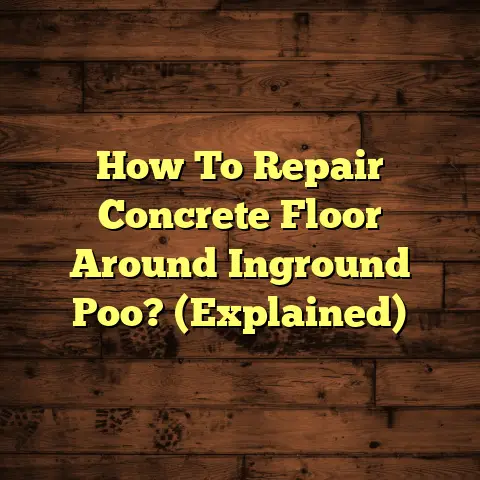Tile Durability: What to Know (2 Critical Flaws!)
Choosing the right tile is super important, whether it’s for your kitchen floor, bathroom walls, or even an outdoor patio.
Durability is the name of the game. It dictates how long your tiles will last and how well they’ll perform.
As a flooring contractor with years under my belt, I’ve seen it all.
I’m going to share some expert picks and, more importantly, reveal two critical flaws that can make or break your tile investment.
Think of this as your insider’s guide to ensuring your tile stands the test of time. Ready to dive in?
Section 1: Expert Picks for Durable Tiles
Okay, let’s talk about some rockstar tiles. These are the ones that contractors like me consistently recommend for their durability.
1. Porcelain Tile: This is my go-to for high-traffic areas. It’s fired at super-high temperatures, making it incredibly dense and resistant to water.
The Porcelain Enamel Institute (PEI) rating is a good indicator. A PEI rating of 3 or higher is what you want for most residential floors.
“Porcelain tile is virtually impervious to water damage,” says Tom Meehan, a certified tile installer and consultant.
I’ve used porcelain in countless kitchens and bathrooms, and it always delivers.
2. Ceramic Tile: Ceramic is another popular choice, but it’s generally less dense than porcelain.
It’s still durable, especially for walls and areas with lighter foot traffic.
It’s more affordable than porcelain, making it a great option if you’re on a budget.
3. Natural Stone Tile (Granite, Slate, Travertine): Natural stone is gorgeous, but it requires more maintenance.
Granite is the toughest of the bunch, known for its resistance to scratches and stains.
Slate offers a unique, rustic look and is naturally slip-resistant.
Travertine is softer and more porous, so it needs to be sealed regularly.
“Natural stone adds a touch of luxury,” says Sarah Walker, an interior designer specializing in sustainable materials.
“But it’s crucial to understand the specific needs of each type.”
4. Quarry Tile: This is a workhorse. It’s unglazed and super durable, often used in commercial kitchens and industrial settings.
It’s incredibly resistant to slips, stains, and impacts.
While it might not be the most stylish choice, it’s hard to beat for sheer durability.
5. Through-Body Tile: This type of tile has the same color and pattern throughout the entire tile.
So, if it chips, the damage is less noticeable compared to a tile with just a surface glaze.
It’s a smart choice for high-traffic areas where wear and tear are inevitable.
Real-World Example: I recently installed porcelain tile in a busy restaurant kitchen.
After two years of heavy use, it still looks brand new.
That’s the power of choosing the right tile!
Section 2: The Science of Tile Durability
Ever wondered what makes some tiles tougher than others? It’s all about the science!
Materials and Manufacturing: The type of clay used, the firing temperature, and the manufacturing process all play a crucial role.
Porcelain, for example, is made from a fine clay and fired at temperatures above 2,200 degrees Fahrenheit.
This creates a dense, non-porous tile.
Ratings and Classifications: Understanding tile ratings is key.
- PEI Rating: As I mentioned earlier, this measures a tile’s resistance to abrasion. Higher numbers mean greater durability.
- Water Absorption Rate: This indicates how much water a tile can absorb. Porcelain has a very low water absorption rate (less than 0.5%), making it ideal for wet areas.
- Coefficient of Friction (COF): This measures slip resistance. A higher COF means a less slippery surface. Important for bathrooms and entryways!
Lifecycle of Tile: Durability isn’t just about the tile itself. It’s also about how it’s installed and maintained.
Proper installation ensures the tile is supported and won’t crack under pressure.
Regular cleaning and sealing prevent stains and water damage.
Table 1: Tile Durability Comparison
| Tile Type | Material | Firing Temperature | PEI Rating | Water Absorption |
|---|---|---|---|---|
| Porcelain | Fine Clay | >2200°F | 3-5 | <0.5% |
| Ceramic | Clay | 1800-2000°F | 1-3 | 3-15% |
| Granite | Natural Stone | N/A | N/A | <0.5% |
| Slate | Natural Stone | N/A | N/A | 0.1-1% |
| Quarry | Shale/Clay | >2000°F | 4-5 | 3-7% |
Source: Tile Council of North America (TCNA) Handbook
Section 3: Two Critical Flaws in Tile Durability
Okay, here’s the juicy part. Even the most durable tile can fail if you don’t watch out for these two critical flaws.
Flaw One: Improper Installation Techniques
This is HUGE. I can’t stress this enough.
Even the best tile will crack, chip, or lift if it’s not installed correctly.
Common Installation Mistakes:
- Inadequate Subfloor Preparation: This is the number one culprit. The subfloor needs to be level, clean, and stable. If it’s not, the tile will eventually crack.
- Incorrect Adhesive Application: Using the wrong type of mortar or not applying it properly can lead to weak bonds.
- Insufficient Grout: Grout fills the gaps between tiles and prevents water from seeping in. If it’s not applied correctly, moisture can damage the subfloor.
- Not Using Expansion Joints: These are crucial in large areas to accommodate movement and prevent cracking.
Expert Opinion: “Proper subfloor preparation is 90% of a successful tile installation,” says Mike Holmes, a renowned contractor and TV personality.
“Don’t cut corners on this step!”
Real-Life Scenario: I once had to redo an entire bathroom floor because the original installer didn’t properly level the subfloor.
The tiles started cracking within months. It was a costly mistake for the homeowner.
Best Practices:
- Hire a Qualified Professional: This is the best way to ensure a proper installation. Look for certified tile installers with years of experience.
- Follow Manufacturer’s Instructions: Always follow the manufacturer’s recommendations for mortar, grout, and installation techniques.
- Inspect the Subfloor: Make sure the subfloor is level, clean, and stable before starting the installation.
Flaw Two: Environmental Factors and Maintenance Neglect
Even with a perfect installation, your tile can suffer if you neglect maintenance or expose it to harsh conditions.
Environmental Conditions:
- Humidity: High humidity can damage grout and lead to mold growth.
- Temperature Fluctuations: Extreme temperature changes can cause tiles to expand and contract, leading to cracks.
- Harsh Chemicals: Using harsh cleaning products can damage the tile’s surface and grout.
Role of Regular Maintenance:
- Cleaning: Regular cleaning with a mild detergent and water is essential to remove dirt and grime.
- Sealing: Sealing grout helps prevent water and stains from penetrating.
- Re-Grouting: Over time, grout can crack and crumble. Re-grouting is necessary to maintain a watertight seal.
Case Study: I inspected a tile floor in a sunroom that had been neglected for years.
The grout was cracked and stained, and some of the tiles were loose.
The homeowner had never sealed the grout or cleaned the floor properly.
The cost to repair the damage was significant.
Proactive Care Tips:
- Clean spills immediately: Don’t let spills sit on the tile surface.
- Use mats and rugs: Protect high-traffic areas from wear and tear.
- Seal grout regularly: Re-seal grout every 1-2 years.
- Use the right cleaning products: Avoid harsh chemicals and abrasive cleaners.
- Ventilate wet areas: Ensure good ventilation in bathrooms and kitchens to prevent humidity buildup.
Section 4: Conclusion
So, there you have it! Choosing durable tile is just the first step.
Understanding the science behind tile durability and avoiding these two critical flaws is essential for a long-lasting and beautiful installation.
Remember, expert recommendations can guide you to the right tile for your needs.
But proper installation and maintenance are equally important.
By making informed choices and taking proactive care, you can ensure your tile investment pays off for years to come.
Happy tiling!





